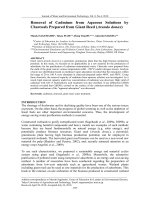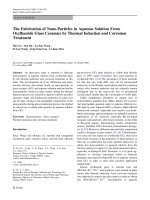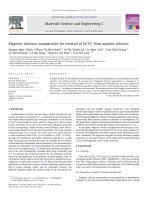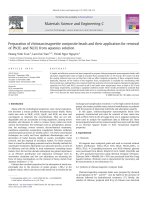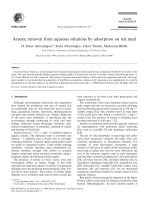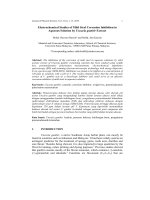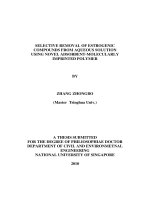Ammonium removal from aqueous solution by silver nano particles
Bạn đang xem bản rút gọn của tài liệu. Xem và tải ngay bản đầy đủ của tài liệu tại đây (1.22 MB, 49 trang )
THAI NGUYEN UNIVERSITY
UNIVERSITY OF AGRICULTURE AND FORESTRY
VU TRA GIANG
AMMONIUM REMOVAL FROM AQUEOUS SOLUTION BY
SILVER NANO PARTICLES
BACHELOR THESIS
Study Mode:
Full-time
Major:
Environment Science and Management
Faculty:
Advanced education program office
Batch:
2014 - 2018
Thai Nguyen, May 31, 2018
Thai Nguyen University of Agriculture and Forestry
Degree Program
Bachelor of Environmental Science and Management
Student name
Vu Tra Giang
Student ID
DTN 1454290072
Thesis title
Ammonium removal from aqueous solution by silver
nano particles
Supervisor(s)
Dr. Van Huu Tap (Thai Nguyen University of Science)
Supervisor’s signature (s)
Abstract: NH4+ is a pollutant from human activities that affects the health of plants,
animals and human. It’s very important to remove it from contaminated waters. This
study aims at synthesizing silver nanoparticles (AgNPs) by chemical reduction
method. In this work, silver nanoparticles were prepared using silver nitrate with a
reducing agent is sodium borohydride and Poly Vinyl Pyrrolidone (PVP) which is
used as stabilizing agents. The size of crystalline for AgNPs was measured by UV–
vis spectroscopy and flourier transform infrared (FTIR). The properties of nanosilver particles (AgNPs) have been studied using scanning electron microscope
(SEM). The capability of nanoparticles to remove NH4+ from contaminated solution
was then studied. Parameters like types of AgNPs, pH of ammonium solution,
contact time, adsorbent dosage and initial ammonium concentration were studied.
Ammonium removal increased when increased in the adsorbent dosage (from 0.228
i
mg/25mL to 2.28 mg/25mL), pH from 3 to 9, contact time from 5 to 60 and
decreased in initial concentration of NH4+. The most appropriate conditions for
Ammonium adsorption onto AgNPs in batch experiments obtained at pH 9, contact
time of 60 min, 1.824 mg AgNPs/25 mL of Ammonium solution with initial
concentration of 5 mg/ L. At this condition, the highest adsorption capacity of
Ammonium onto AgNPs reached 100.48 mg/g.
Isotherm adsorption was also
described by the Langmuir model with a constant correlation (R2) is 0.9339. . With
highest R2 (0.885), the adsorption kinetic of Ammonium onto AgNPs obeyed
Elovich model with the chemical sorption process.
Keywords
Ammonium, AgNPs, Adsorption
Number of pages:
41
Date of submission:
15/09/2018
ii
ACKNOWLEDGEMENT
I would like to express my special thanks of gratitude to Dr. Van Huu Tap who in spite
of being extraordinarily busy with his duties, took time out to hear, guide, keep me on
the correct path and complete report during the time of conducting the research, which
also helped me know about so many new things I am really thankful to him.
I would also like to express my great appreciation to Dr. Vu Xuan Hoa for his constant
support, patient guidance and suggestions related to my work.
Finally, I would also like to thank my parents and friends who helped me a lot in
finalizing this project within the limited time frame.
Thank you all very much!
Thai Nguyen, August 2018
Student
Vu Tra Giang
iii
TABLE OF CONTENTS
ACKNOWLEDGEMENT ........................................................................................... iii
LIST OF FIGURES ..................................................................................................... vi
LIST OF TABLES ...................................................................................................... vii
LIST OF ABBREVIATIONS ................................................................................... viii
PART I. INTRODUCTION ......................................................................................... 1
1.1.
Research rationale ............................................................................................. 1
1.2.
Research’s objectives ........................................................................................ 2
1.3.
Research’s questions and hypothesizes ............................................................. 2
1.4.
Limitations......................................................................................................... 3
PART II. LITERATURE REVIEW ........................................................................... 4
2.1.
Ammonium ion.................................................................................................. 4
2.1.1.
Ammonium ion in water ............................................................................ 4
2.1.2.
Sources of Ammonium pollution .............................................................. 5
2.1.3.
Standard of Ammonium ion in water ....................................................... 7
2.2.
Effect of Ammonium ........................................................................................ 8
2.3.
Silver nanoparticles ........................................................................................... 8
2.4.
Adsorption ......................................................................................................... 9
2.5.
Research projects on ammonium treatment .................................................... 10
PART III. METHODOLOGY ................................................................................... 11
3.1.
Materials .......................................................................................................... 11
3.1.1.
Laboratory instruments ........................................................................... 11
3.1.2.
Ammonium NH4+ solution ...................................................................... 11
3.1.3.
Preparation of adsorbent (AgNPs).......................................................... 11
3.2.
Adsorption experiments of Ammonium (NH4+) onto AgNPs ......................... 12
3.2.1.
Method of ammonium analysis ............................................................... 14
3.2.2.
Measurements .......................................................................................... 15
3.2.3.
Data analysis ............................................................................................ 16
PART IV. RESULTS AND DISSCUSSION............................................................. 17
4.1.
Characterization of Silver nanoparticles (AgNPs) .......................................... 17
iv
4.2.
Effect of type AgNPs ...................................................................................... 19
4.3.
Effect of pH ..................................................................................................... 19
4.4.
Effect of contact time ...................................................................................... 21
4.5.
Effect of adsorbent dose .................................................................................. 23
4.6.
The effect of NH4+ concentrations .................................................................. 24
4.7.
Adsorption isotherm ........................................................................................ 25
4.8.
Adsorption kinetics of AgNPs......................................................................... 29
PART V. CONCLUSIONS ........................................................................................ 33
REFERENCES ............................................................................................................ 34
v
LIST OF FIGURES
Figure 1: The relationship between Ammonia Ionization and pH ..................................... 5
Figure 2. Characteristic of AgNPs: (a) The absorption spectra of silver solution; (b)
The TEM image of the AgNPs; (c) The distribution of AgNPs size obtained from Fig.
2b; (d) FTIR spectra of pure starch and ST0.2 sample; (e) XRD patterns of synthesized
AgNPs. ............................................................................................................................... 18
Figure 3. Effect of types of AgNPs on adsorption of Ammonium ................................... 19
Figure 4. Effect of pH on adsorption of Ammonium by AgNPs ...................................... 21
Figure 5. Effect of contact time on adsorption of Ammonium by AgPNs ....................... 22
Figure 6. Effect of AgPNs dose on adsorption of Ammonium ........................................ 23
Figure 7. Effect of initial Ammonium concentration ....................................................... 25
Figure 8. Equilibrium adsorption prediction of Ammonium on AgNPs by Langmuir
and Freundlich models (contact time= 60 min, Co =10 mg/L) .......................................... 27
Figure 9. Kinetics modelling of NH4+ sorption onto AgNPs (Co: 10 mg/L; adsorbent
dose: 1.6 mL/25 mL; initial pH: 9) .................................................................................... 31
vi
LIST OF TABLES
Table 1: Adsorption isotherm parameters and correlation coefficients of Langmuir and
Freundlich models for Ammonium adsorption on AgNPs ................................................ 28
Table 2: Calculated kinetic parameters of models of Ammonium adsorption on
AgNPs ................................................................................................................................ 30
vii
LIST OF ABBREVIATIONS
NPs
Nano particles
AgNPs
Silver nano particles
Hb
Hemoglobin
NH4+
Ammonium ions
WHO
World Health Organization
viii
PART I. INTRODUCTION
1.1.
Research rationale
The treatment of nitrogen compounds (nitrate, nitric and ammonia nitrogen) directly
from water plants or indirectly from agriculture and filtering from sludge into landfill
and fields led to eutrophication of the muscles, water body. It has been widely reported
that ammonium nitrate (NH4+-N) is a very common chemical species in aquatic
ecosystems and its toxic effect on life is very high (Haseena.P.V et al., 2016).
Water contains ammonium, nitrite, and nitrate, the result of the decomposition of
organic matter or pollution from waste water. In particular, ammonium is the most
toxic for fish and aquatic species. Nitrite is formed from the reaction of organic and
ammonium nitrate and with the participation of bacteria. The nitrite is then oxidized to
nitrate. In addition, nitrate is present in the water source due to wastewater from the
chemical industry, from the field using chemical fertilizers, landfill leaks, and rain
water runoff. The presence of nitrogen compounds in the chemical composition of
water indicates signs of water pollution. Clean water standards specify that ammonium
is less than 3 mg/l. The drinking water standard specifies that Ammonium is less than
1.5 mg/l (WHO).
Ammonium itself is not too toxic to the body, but if it is present in water at levels
beyond the allowed standard it can be transformed into carcinogens and other
dangerous diseases. Studies have shown that 1g of ammonia is converted to 2.7 g of
nitrite and 3.65 g of nitrate while the content of nitrite is 0.1 mg / liter and nitrate is
10-50 mg / liter (Europura, 2016).
1
Ammonium contamination in the groundwater as a source of water for living has been
studied in many areas, many countries in the world. There are many methods, such as
biological, physical, chemical, or a combination of these methods, have been
developed for the removal of ammonium from wastewaters.
In order to solve the defects of traditional absorbents, nanomaterials were used as
novel substances to remove pollutants from water and wastewater. Materials of size
from 1 nm to 100 nm are defined as nanomaterials. With its properties dependent on
shape and fiction, nanomaterials have been extensively studied for more than a decade.
In recent years, the development of nanoscale science and nanotechnology has shown
significant potential in overcoming environmental problems (Lee J et al., 2010, Ali I.
2012). Compared with traditional materials, nanocomposite adsorbent have shown
higher efficiency and faster water treatment rates.
1.2.
Research’s objectives
In recent years, the method of adsorption is receiving much attention from researchers
to contribute to eliminating environmental pollution. However, studying the adsorption
capacity of AgNPs in water treatment is a new direction, not much research work.
AgNPs are a small size material that is able to retain some of the substance. This
surface can be an absorbent material. Therefore, in this study, AgNPs were synthesised
and used to remove ammonium in aqueous solution by adsorption method in
laboratory condition.
1.3.
1.
Research’s questions and hypothesizes
What kind of AgNPs has effect on Ammonium absorption?
2.
What are the optimal conditions to have the best effect?
2
1.4.
Limitations
In the laboratory do not have enough machines therefore; some parts have to send to
another laboratory in Hanoi to get the result.
3
PART II. LITERATURE REVIEW
2.1.
Ammonium ion
2.1.1. Ammonium ion in water
Nitrogen is an important factor of the biogeochemical cycle, involving the transfer of
essential nutrients from living organisms to the environments and vice versa. The
biological cycle of nitrogen consists of both natural and man-made components and it
is subject to great complexity due to the variety of compounds and associated
variations (Dekker et al., 2000, Franson et al., 2005). In water, dissolved ammonia
exists in two types of equilibrium: free ammonia (NH3) and dissolved ammonium
(NH4+) (Waite et al., 1984)
NH4+
H2O ↔ NH3
H3O+
The NH3 - NH4+ balance is extremely dependent on pH and at lower levels of salinity
and temperature. At typical pH of natural waters, NH4+ is dominant (Lee J et al.,
2010).
From the Fig.1, the pH is low, the equilibrium shifts to the right: more ammonia
molecules are transferred into ammonium ions. Conversely, if the pH value of water is
high (the concentration of hydrogen ions is low), the equation shifts to the left:
the hydroxide ion isolates a proton from the ammonium ion, which create ammonia.
4
Sourse:
Figure 1: The relationship between Ammonia Ionization and pH
2.1.2. Sources of Ammonium pollution
Ammonium is produced from both natural and human sources. Although natural
sources are responsible for most of its content in the country, human origins have been
greatly increased in the last century (Dekker et al., 2000, Franson et al., 2005 and
Waite et al., 1984).
There are many causes of ammonium contamination in the groundwater but one of the
main causes is the overuse of organic fertilizers, pesticides, chemicals and plants. They
damage to water sources, or the decomposition of organic compounds and substances
that accelerate ammonium contamination in the groundwater. In addition, the level of
pollution depends on the type of cultivation of each area (Nguyen Viet Anh, 2005).
Due to geological structure and history of stratigraphic formation
5
The results of geological activities (erosion, etc.) have formed on the Quaternary
pebble aquifer. This is the main source of water used to supply water for living
activities of people. The fourth floor consists of many types of tectonics with different
sediments of origin. Generally, these layers contain peat particles, soils with organic
compounds. The ability to move dirt into the water is closely related to the grain
composition. Particularly dried particles have greater flow, small absorption capacity,
easy to move dirt, fine particles and the opposite.
As the process of extracting water expands, the release of nitrogen-containing
compounds is generated in the muddy soil that contains many decomposing organic
substances, which results in increased nitrogen content in the groundwater.
Due to the existence of pollution sources located above the ground
Over the years, with the development of social life, the development of industry and
agriculture we have emitted into the environment a large amount of waste, including
both water and wastewater. They have high levels of organic pollutants.
In addition, the extraction of the groundwater with large volumes of new water cannot
be timely and has created the hopper to lower the water level, which also contributes to
the penetration of dirt faster. In order to compensate for the amount of groundwater
being extracted, the natural erosion process is accelerated, and the groundwater is
supplemented by seepage from surface water. This is the cause of increased levels of
pollutants in groundwater by artificial origin. Due to the discharge of large amounts of
wastes, wastewater containing many water-soluble nitrogen-containing compounds
results in an increase in the concentration of nitrogen in surface water as the product of
6
urea, ammonium and salt production. Ammonium from fertilizers, from rotting and
from domestic wastewater and industrial effluent ... These substances, by surface
water, penetrate downwards from the top or through the sides of rivers, penetrate the
groundwater. to increase the concentration of ammonium in groundwater.
Due to the ventilation zone thickness
When the thickness of the ventilation zone (or infiltration thickness) is reduced, the
possibility of penetrating contaminants into the aquifer is higher. But for nitrate and
nitrite alone, the thickness of the aeration zone is too great, the nitrification process is
favorable, and the thickness of the aeration zone is too small, the nitrification process
is weaker.
In reality, as the zone of ventilation becomes thicker, the amount of oxygen entering
the atmosphere and other sources on the ground into the ventilation zone will be large,
facilitating the favorable conditions for the development of the micro Aerobic bacteria.
As a result, nitrification occurs and NO2 and NO3 levels increase.
Due to the large hydraulic slope
Areas with strong currents increase the penetration of pollutants into groundwater.
Areas below steep slopes tend to have higher levels of contamination than low slopes.
This is consistent with the laws of physical motion of matter.
2.1.3. Standard of Ammonium ion in water
For ammonium in drinking water, an indicator parameter of 0.50 mg/L has been laid
down in the European Union legislation. The indicator parameter has been set based
7
on technological reasons and does not imply a health concern at concentrations higher
than 0.50 mg/L (European Food Safety Authority, 2012).
2.2.
Effect of Ammonium
When exceeded, ammonia leads to excessive biomass growth, disturbing the
ecological balance of the water column. Although micronutrients, ammonia causes
many side effects in living organisms (Dekker, 2000, Franson, 2005 and Waite, 1984).
With ammonium chloride, the acidic effects of chloride ions seem to be of greater
importance than ammonium ions. Ammonium chloride affects metabolism by shifting
acid-base balances, impaired glucose tolerance and reduced insulin-sensitization at
doses above 100 mg/kg body weight per day (33.7 mg ammonium ion/kg body weight
per day) (US Environmental Protection Agency, 1989).
The main biological effect of nitrite in humans is its involvement in the normal
oxidation of Hb to methaemoglobinaemia, which cannot transport oxygen to tissues.
Oxygen reduction becomes clinically apparent when the concentration of
methamphetamine reaches 10% of normal Hb concentration; this condition, called
methaemoglobinaemia, causes cyanosis and, at higher concentrations, causes asphyxia.
Normal human hemoglobin levels are below 2%; in infants less than 3 months old, less
than 3% (WHO, 2011).
2.3.
Silver nanoparticles
Nanotechnology is an important part of modern research relating to design, synthesis,
and manipulation of particle structures ranging from approximately 1-100 nm.
8
Nowadays, Nanoparticles (NPs) applied in wide range areas such as medicine,
manufacturing and materials, environmental health, energy and electronics
(Understanding nano, 2018).
Silver nanoparticles (AgNPs) have been applied in various fields, including medical,
food, health care, consumer, and industrial purposes and environment due to their
unique physical and chemical properties. For the environment, silver nanoparticles are
antimicrobial agent as well as in the removal of pollutants and toxic materials (e.g.
Methylene Blue, Iodide and bromide ions, Bacterial pathogen) (Park J. Y. et al., 2011,
Polo M. S. et al., 2006, Krishna S. et al., 2009,)
2.4.
Adsorption
Absorption is a surface phenomenon where the adsorbent is a sticky substance to
another substance on its surface. A substance which accumulates on the surface of
adsorbent is named adsorbate. Adsorption can be a chemical or physical process, or a
combination of them, occurs at the boundary of two phases, such as liquid - solid, gas solid, gas - liquid or liquid – liquid (Fomkin A, 2009). In other words, the adsorption is
a change in the concentration of a certain substance (e.g. contaminant) at an interface
with an initial reduction in concentration. Adsorption has importance for industries
which work with air and water purification.
2.4.1. Adsorption capacity
Adsorption capacity (q) is the amount of adsorbed substance (adsorption) by 1 gram of
solid adsorbent (Le Van Cat, 1999) calculated as:
9
Where:
q: amount of adsorbed material (mg / g).
C0, C: initial concentration and concentration of adsorbed substance (mg / l).
V: volume of solution (l).
m: weight of absorbent (g).
2.4.2. Adsorption effeciency
Adsorption efficiency (H) is the ratio between the concentration of the adsorbed
solution (C) and the initial solution concentration C0. (Mohammad et al., 2011)
2.5.
Research projects on ammonium treatment
Many methods, such as biology, physics, chemistry, or combination of these methods,
have been developed to remove ammonium from wastewater and other point sources.
They mainly include ion exchange and adsorption, biotechnology, dechlorination,
chlorination, chemicals, reverse osmosis, microwave radiation, and supercritical water
oxidation (Bermejo et al., 2008; Bernet et al., 2000; Bodalo et al., 2005; Booker et al.,
1996; Guštin and Marinšek-Logar, 2011; Huang et al., 2015a; Lin et al., 2009;
Siegrist, 1996; Turan, 2016).
10
PART III. METHODOLOGY
3.1.
Materials
3.1.1. Laboratory instruments
Tool:
Standard bottle 25 ml.
Triangle bottle 100 ml.
Pipet.
Filtration funnel
Squeeze, filter paper, dropper
Device:
Analytical balance.
UV-VIS Visible Spectrometer (Hitachi Z 2000, Japan)
Shaker machine (HY 2A, China).
pH meter (Hanna HI 9025, Romania)
3.1.2. Ammonium (
) solution
A stock solution of ammonium (NH4+) with a concentration of 1000 mg/L was
prepared from dissolving accurately 0.9541 g of Ammonium chloride of (
) in
250 mL of double distilled water. Working solutions were prepared by diluting the
stock solution with double distilled water to the desired concentrations.
3.1.3. Preparation of adsorbent (AgNPs)
There were 6 kinds of AgNPs used in this study:
1:16
GLED 1h
GLED 1h30
GLED 2h30
GLED 3h30
SEED
11
Nanosized metal colloids are synthesized by reduction method.
Chemical reduction of silver nanoparticles involves the reduction of a silver salt (silver
nitrate) with a reducing agent is sodium borohydride in the presence of colloidal
stabilizer. Sodium borohydride has been used with Poly Vinyl Pyrrolidone (PVP)
which is used as stabilizing agents.
The synthesis of colloidal silver nanoparticles (AgNPs) was performed using NaBH 4
as the reducing agent. First, a 100 ml of a 10-3M solution of AgNO3 were mixed with
the amount of 0.2 g of PVP to generate starch solutions containing Ag+ ions. Second,
the solution was stirring vigorously on a magnetic stirrer at 70o C to ensure that the
mixture was homogeneous. While the solution was stable at 70oC, a 25 ml of 10-3 M
sodium borohydrides solution was added gradually (drop by drop) to the solution.
There acted solutions then cooled to room temperature. The chemical reaction is the
sodium borohydride reduction of silver nitrate (Sally D S et al., 2007)
AgNO3+ NaBH4 →Ag0 +
1
1
H2+ B2H6 + NaNO3
2
2
The PVP containing Ag+ solutions turned to light yellow after the addition of the
sodium borohydrides solution and to brighter yellow when all of the sodium
borohydride solution had been added. The overall reaction process was carried out in
the dark box to avoid unnecessary photochemical reaction (Benjamin L O et al., 2015).
3.2.
Adsorption experiments of Ammonium (NH4+) onto AgNPs
12
Experiments were performed by using batch modes. A suck out of AgNPs was placed
into 100 mL conical flasks containing 25 mL of
solution with concentrations
of NH4+ was 10 mg/l. The adsorption experiments of NH4+ were conducted in batch
shake-flasks shaken at 120 rpm orbital for 60 min, at room temperature (25±20C).
The effects of pH on NH4+ adsorption onto AgNPs were conducted by putting 1.14mg
of AgNPs in 25 mL of
solution containing 10mg/L of NH4+ in 100 mL conical
flasks. PH were adjusted between 3 and 10 using either H2SO4 1M or NaOH 1M
solution. The conical flasks containing NH4+ solution were shaken for 60 min at 120
rpm orbital, at room temperature (25±20C).
The effects of contact time on adsorption capacity of NH4+ were conducted with
changing of contact time from 5 to 180 min with the optimal of NH4+ pH value
determined in above experiments with 1.14 mg of AgNPs in 25 mL of
solution
(10mg/l). The mixtures were placed in to 100 mL conical flasks and then were shaken
at 120 rpm orbital, at room temperature (25±20C).
Effects of AgNPs doses on adsorption of NH4+ were performed by putting a dose of
AgNPs varying in range from 0.2 to 2 ml (0.228 mg – 2.28 mg) AgNPs/25 mL of
NH4+ solution with concentration of NH4+ was 10mg/l. The experiments also were
adjusted to optimal pH value and contact time that was determined as above described
experiments. The conical flasks were shaken at 120 rpm orbital for optimal contact
time, at room temperature (25±20C).
The effects of initial NH4+ concentrations were evaluated by placing each 25 mL
solution containing NH4+ adjusted to an optimum pH value that was
13
determined in above described experiments with varying of initial concentrations from
5 to 80 mg /L into 100 mL conical flasks with optimal dose of AgNPs. Finally, the
conical flasks were shaken at 120 rpm orbital for optimal contact time, at room
temperature (25±20C).
3.2.1. Method of ammonium analysis
To determine the amount of NH4 + remaining after the experiment, we went to color
directly with Nessler reagent.
Scope of application
Ammonia that is present in water is due to the decomposition of organic matter under
anaerobic conditions, or water contaminated by the waste. This method is used to
determine the content of ammonia for surface water, water supply, wastewater and
natural water such as rain water and groundwater.
Principle method
Colorimetric rule with nessler reagents: Ammonium in the alkaline medium reacts
with the Nessler reagent (K2HgI4), which forms a yellow or dark brown complex
depending on the ammonia content of the water (when the Nessler reagent) In the
solution, the ammonium reacts very quickly to this agent producing yellowish or
brown color, but not all of the ammonium reacts immediately so it takes time for the
solution to grow darker. The color intensity is proportional to the ammonium content
of the test solution measured at 450 nm.
We have a reaction:
2K2HgI4 + NH3 + 3KOH → Hg(HgIONH2) + 7KI + 2H2O (yellow) 2K2 HgI4 +
NH3 + KOH → Hg(HgI3NH2 ) + 5KI + H2O (yellowish brown)
14
But natural water often contains Ca2+ ions, Mg2+ ions (hard water). In strong bases,
these ions form hydroxides in the colloidal form, causing the solution to melt away. To
overcome this phenomenon, use Seignett salt (KNaC4H4O6), or EDTA for analysis, so
that these salts combine with Ca2+ and Mg2+ ions to form soluble, colorless solvents in
solution.
M+ + KNaC4H4O6→ K+ + Na+ + MC4H4O6
M2+ + Na2H2I → Na2MI + 2H+
Impact of obstruction
Iron ions, the high hardness of the water cause the reaction to react. This factor
is eliminated by Natri Kalitartrat.
Chlorinated water interferes with the colorimetric process, so samples should be
filtered before analysis and use of 5% zinc sulphate solution.
Excess chlorine in water at high concentrations reduces the amount of ammonia
in the sample, so it is necessary to remove excess chlorine in water with a 5% sodium
thiosulfate solution.
Conditions to proceed
After creating the conditions for the sample, allow the solution to stand for 10
to 15 minutes for maximum color intensity.
Glassware should be cleaned with a rinse solution and then thoroughly rinsed
with distilled water.
3.2.2. Measurements
NH4+ concentrations in the bulk reactor suspensions of all samples in the above
experiments were measured. NH4+ was measured by Photometric method on UV-vis
15
(Hitachi Z 2000, Japan). The pH was measured by pH meter (Hanna HI 9025
Romania).
3.2.3. Data analysis
All experiments were performed in triplicate. All data statistics, comprising means,
standard deviations, relative standard deviations and regressions (linear) were
computed with tools in MS Excel. The highest acceptable deviation was 5%. The error
bars indicating the standard deviation was shown in all figures wherever possible.
16
